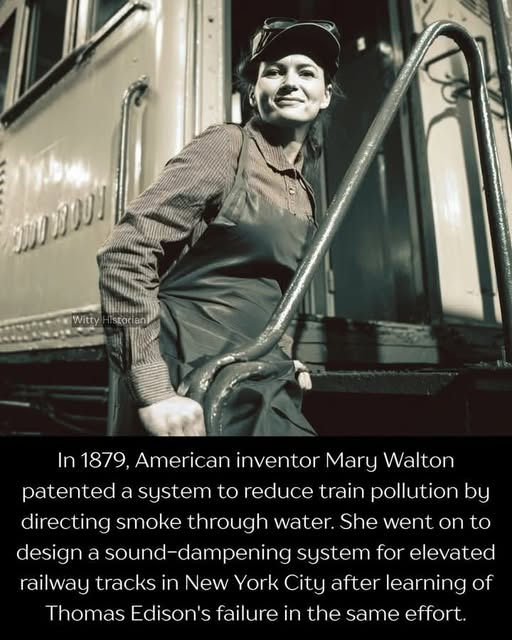
In 1879, Mary Walton, a pioneering American inventor, patented a revolutionary system to combat one of the era’s most pressing urban problems—train pollution. Her invention channeled smoke emissions through water to trap harmful particles, dramatically improving air quality in cities blanketed by industrial soot. At a time when pollution was accepted as the cost of progress, Walton’s solution was visionary—an early example of environmental engineering designed to protect public health.
But Walton’s brilliance didn’t stop at smoke. When she learned that Thomas Edison had failed to reduce the deafening noise of New York City’s elevated trains, she took matters into her own hands. Where Edison’s method of sound-dampening fell short, Walton’s approach succeeded. She developed a sound-absorbing system that significantly reduced noise levels, offering much-needed relief to urban dwellers. Her innovation wasn’t just technically superior—it was transformative for city life.
Though her achievements weren’t widely celebrated in her time, Mary Walton’s work laid crucial groundwork for modern environmental technology. Her story reminds us that women have long been powerful forces in science and engineering—often unrecognized, but deeply influential. Walton’s legacy is a testament to innovation born from empathy, persistence, and a clear vision for a cleaner, quieter future.
alton didn’t stop with pollution control. After learning of Thomas Edison’s failure to reduce noise from elevated railway tracks in New York City, she took it upon herself to tackle the problem. Edison’s method of sound-dampening for railway tracks had proven unsuccessful, but Walton saw it as an opportunity. In response, she developed a new sound-dampening system that was more effective, offering relief to New Yorkers who lived near the noisy and disruptive elevated trains. Her success in this venture further demonstrated her ability to solve complex issues and her critical role in shaping early environmental engineering.
Walton’s contributions to industrial innovation helped shape the way cities dealt with pollution and noise in the late 19th century. While her inventions were not widely celebrated during her time, her work laid the groundwork for later advancements in environmental engineering. Her legacy is an example of how women in science and engineering, though often overlooked, have made significant contributions to technological progress and urban development. Walton’s work remains a testament to the power of innovation in improving public health and quality of life.
In the grand narrative of American innovation during the Industrial Revolution, many names are etched in textbooks, from Edison to Bell to Ford. But often lost in the shuffle are the unsung heroes — especially the women — whose contributions changed not only the trajectory of science and engineering but also the quality of everyday life. Among them is Mary Walton, a remarkable inventor whose work in pollution control and noise reduction helped shape the urban environments of the late 19th century. While her story might not be as well-known as those of her male counterparts, Walton’s legacy is one of ingenuity, persistence, and foresight. Her innovations were not just clever feats of engineering — they were acts of public service that prefigured the modern field of environmental engineering.
Industrial America and the Urban Crisis
By the late 1800s, the United States was undergoing a rapid transformation. The Industrial Revolution had fueled unprecedented economic growth, urbanization, and technological advancement. Cities expanded rapidly as factories multiplied, railroads crisscrossed the nation, and new forms of energy, transportation, and infrastructure redefined daily life. But with this progress came significant costs — many of which fell squarely on the shoulders of urban residents.
Air pollution choked city skies. Smoke from coal-powered trains and industrial plants darkened the horizon and fouled the air. Noise pollution, an issue rarely considered before the rise of machinery and rail, became a daily torment in growing cities. In places like New York City, the rumble and clatter of elevated railway trains kept neighborhoods awake at night and rattled buildings to their foundations.
These were not small inconveniences. They were public health issues that shaped how people lived, worked, and navigated their environment. Yet, for the most part, they were treated as the unfortunate byproducts of progress — unpleasant, but unavoidable.
That’s where Mary Walton stepped in.
A Woman of Ingenuity in a Man’s World
Mary Walton was not a trained scientist or formally educated engineer. In fact, very little is known about her personal life, which speaks volumes about how women inventors were viewed at the time. What we do know is that she lived in New York City during an era when women were largely excluded from scientific institutions, engineering firms, and patent offices. Despite these barriers, Walton not only invented but patented solutions to two of the most pressing environmental issues of her time.
Her first major contribution came in 1879, at the height of America’s industrial boom. Railroads were the arteries of the nation’s economy, moving goods and people faster than ever before. But they also spewed tremendous amounts of smoke and soot into the air. In cities like New York, this pollution settled on buildings, streets, and lungs — turning vibrant neighborhoods into grimy industrial zones.
The Smoke Solution: Pollution Control Before Its Time
Mary Walton’s first major innovation was a pollution-reduction system for smokestacks, specifically those attached to locomotives. Understanding that the thick black smoke was a mixture of airborne particles and harmful chemicals, she designed a way to funnel smoke emissions through a water tank, where impurities and particulates could be captured and neutralized before being released into the air. It was a simple but brilliant concept — using water as a natural filter to clean the smoke.
Her invention was awarded a patent in 1879, and it was one of the earliest recorded attempts to control urban air pollution in a systematic, technological way. While environmental regulation was still decades away, Walton’s work anticipated core principles of environmental engineering — namely, that industrial processes must be managed not only for efficiency but also for their impact on public health and the environment.
In retrospect, her water-filtration method foreshadowed later developments in air pollution control, including scrubbers, filters, and other exhaust treatment systems. But in the context of her own time, it was extraordinary — both in concept and execution.
Outdoing Edison: Tackling Noise Pollution
Walton’s contributions didn’t stop at cleaning the air. She turned her attention to another major issue: the deafening noise of elevated trains. In the late 1800s, New York City’s transit system included miles of elevated railway tracks that ran above major streets, supported by massive metal structures. The trains that ran along them were incredibly loud. Residents living near the tracks complained of constant clanging and screeching that made sleep and concentration nearly impossible.
Even Thomas Edison — by then one of the country’s most respected inventors — had tried and failed to develop an effective sound-dampening system for the railways. The failure was notable, not just because it was Edison, but because it revealed how intractable the problem seemed. The vibrations from the trains traveled through the steel structures and reverberated into buildings and homes. Solutions attempted by engineers and railway companies fell short.
Enter Mary Walton. Rather than accept the failure, she saw it as a challenge — an opportunity to apply her creativity and practical problem-solving to an issue that directly affected her community. She observed the mechanics of the elevated trains, studied the vibrations, and identified how the sound was being transmitted from the tracks to the metal supports.
Her breakthrough was as elegant as it was effective. She designed a system in which the railway tracks were placed inside wooden boxes lined with cotton and filled with sand — materials known for their ability to absorb sound and vibration. This design significantly dampened the noise produced by the trains and reduced the vibrations that traveled through the structure.
In 1881, she was awarded a patent for this invention as well. More importantly, the Metropolitan Railroad adopted her system. This was not just a validation of her work; it was a direct improvement in the lives of thousands of New Yorkers. Walton succeeded where Edison had failed — not because she had more resources or fame, but because she was deeply connected to the problem and willing to approach it from a new perspective.
The Broader Impact: Environmental Engineering Before It Had a Name
Mary Walton’s inventions had effects far beyond their immediate applications. They marked a fundamental shift in the way people thought about urban living and industrial responsibility. She tackled problems at the intersection of technology, environment, and society — a space that would eventually become the domain of environmental engineering.
Her work contributed to the early understanding that innovation should not merely serve industry or profit but should also improve the quality of life. By developing technologies that addressed both pollution and noise, Walton anticipated modern concepts such as sustainability, environmental justice, and green engineering. She also demonstrated that solutions to complex problems didn’t always require complex answers — sometimes, a bucket of water or a box of sand could do what machinery and money could not.
Furthermore, Walton’s patents serve as important historical documents. They are proof that women were not only present but actively shaping the technological landscape of the 19th century. Her ability to observe, test, build, and patent her ideas in a world that largely excluded women from scientific recognition is itself a powerful legacy.
Why Was She Forgotten?
Despite her contributions, Mary Walton’s name does not appear in most history books or engineering curricula. This is not surprising. The 19th century was not a welcoming place for women in science or invention. The barriers were cultural, legal, and institutional. Women were not admitted to most engineering schools. Their work was often dismissed or claimed by men. They had little access to funding or professional networks.
Even when they did receive patents — as Walton did — their work was rarely promoted or celebrated. In many cases, women’s contributions were either lost to history or attributed to men who worked alongside them. That Walton was able to receive patents and have her work implemented is a testament to the force of her ideas and the practicality of her solutions.
Her story is an important reminder that the history of innovation is incomplete without the inclusion of women and marginalized voices. It prompts us to ask how many other inventors like Mary Walton have been forgotten, not because their ideas were unimportant, but because the world wasn’t ready to listen.
Legacy and Lessons for Today
Mary Walton’s work continues to resonate in the modern world. In an era where climate change, urban noise, and environmental degradation are urgent global concerns, her life reminds us that these problems are not new — and neither are the minds capable of solving them.
Her approach was grounded in observation, empathy, and practicality. She didn’t wait for permission or recognition. She saw problems in her world — dirty air, unbearable noise — and she devised ways to fix them. That mindset is as relevant today as it was in 1879.
Moreover, her story offers vital lessons for education and innovation. It reminds us that the best ideas don’t always come from elite institutions or famous names. Sometimes, they come from people — women, people of color, the working class — who live closest to the problems and therefore have the clearest view of what needs to change.
As we look for new ways to combat urban pollution, to reduce the health impacts of noise, and to build more livable cities, Mary Walton’s contributions deserve to be remembered, studied, and celebrated. Her inventions might seem modest compared to today’s high-tech solutions, but they were revolutionary in spirit — rooted in a belief that technology could serve the public good.
Conclusion: A Quiet Heroine of Industrial Progress
Mary Walton may not be a household name, but her legacy is built into the cities we live in. Her filtration system helped clear the air before most people even understood the danger of industrial smoke. Her sound-dampening design brought relief to thousands long before noise pollution had a name. And her life — quiet, determined, and driven by purpose — reminds us that innovation is not the exclusive domain of the powerful or privileged.
She was a woman ahead of her time, engineering solutions for problems we still face today. Her work was an early call to action — a declaration that progress should not come at the cost of people’s health and peace of mind. In the story of America’s industrial ascent, Mary Walton stands as a figure of uncommon vision and resilience.
She deserves not just a footnote, but a full chapter — in history books, engineering textbooks, and the collective memory of a world that still benefits from her brilliance.


